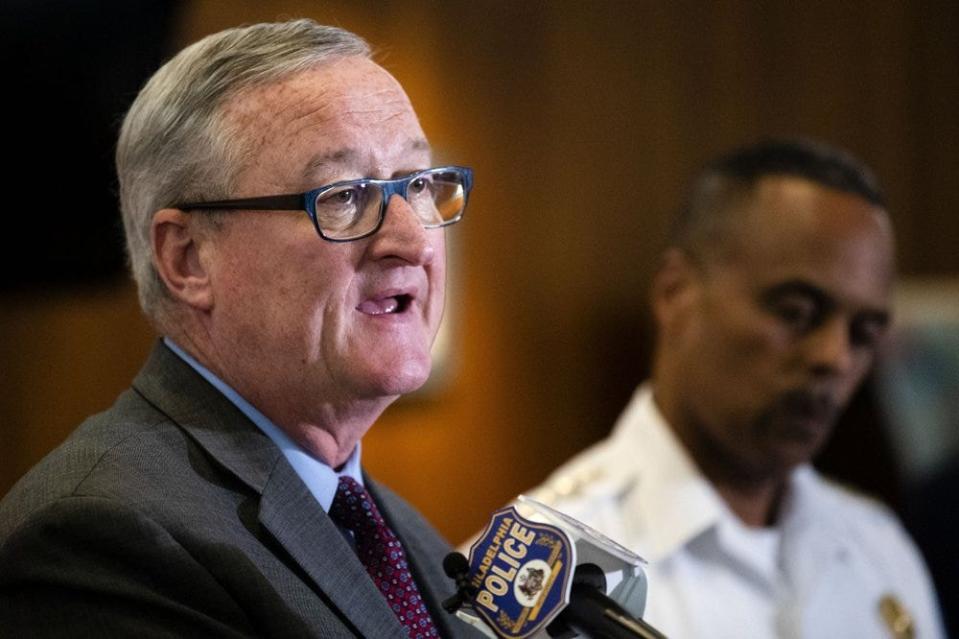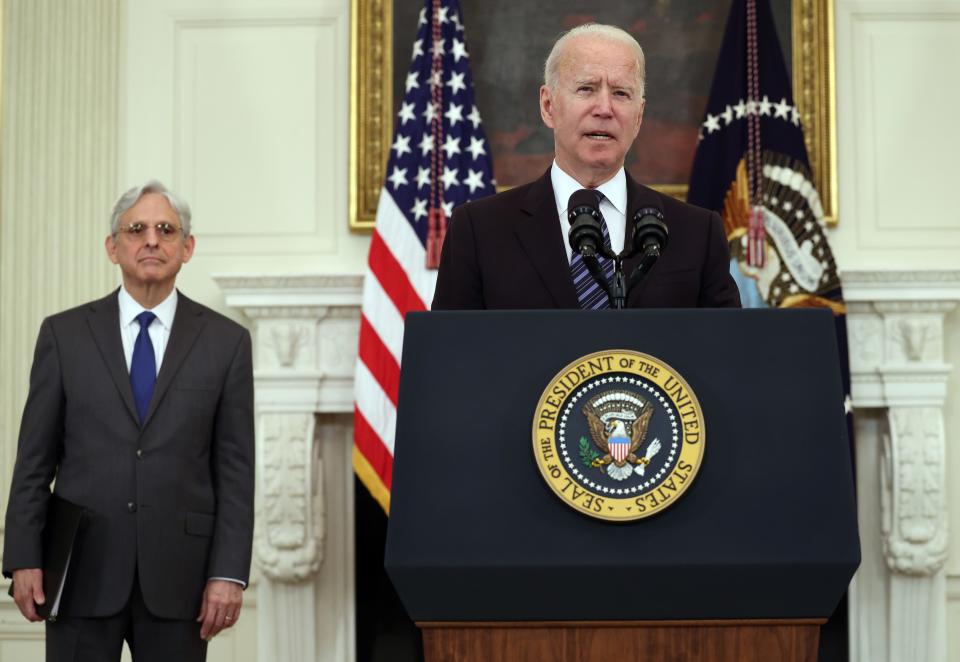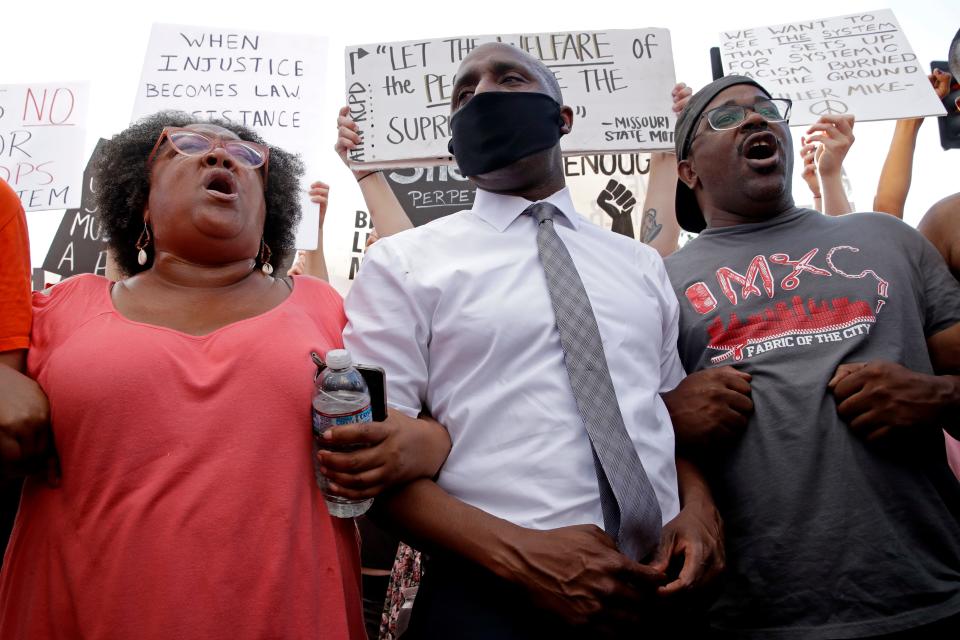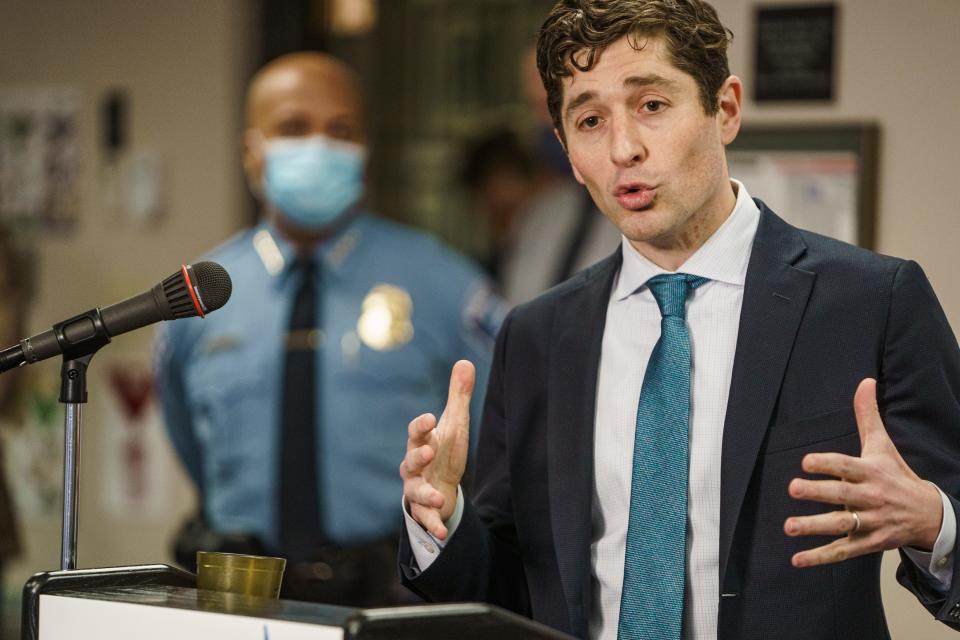Fund the police? Pushed by Biden, Democrat mayors divided how to use COVID money to fight crime
WASHINGTON — After watching homicides in Lorain, Ohio, more than double, Mayor Jack Bradley adjusted quickly when he learned his city could use federal COVID-19 rescue funds to hire more police officers.
An old manufacturing town of 64,000 on Lake Erie, about 30 miles west of Cleveland, Lorain has grappled with 11 homicides so far in 2021, up from five at this time in 2020 and seven total in 2019. Rattling the city further, two auxiliary police officers were injured this month by bullets fired into their vehicle.
Bradley thought using American Rescue Plan funds to beef up law enforcement wasn't an option. Then in a June 23 speech unveiling a crime reduction strategy, President Joe Biden encouraged mayors to use their share of $350 billion in aid on public safety that could include hiring more police officers.
"We noticed that the shooting and murder rates was going up in our community – not just 100%, but several hundred percent," said Bradley, a Democrat, who last week won council approval to spend $6 million in COVID-19 rescue funds to hire 10 new police officers and purchase additional vehicles and equipment. "We decided that was an immediate priority that we needed to address."
More: 'It has to end': Biden targets illegal gun sales, rogue dealers in strategy to combat rising crime
The Biden administration has turned to the direct aid from the American Rescue Plan, approved by Congress in March, as one of its top strategies not only to combat rising crime in cities but to push back at attacks frome Republicans seeking to tie Biden to the calls of progressive activists to "defund the police."
As gun violence has soared amid the pandemic, Republicans have blamed Democratic leadership in cities, previewing a likely line-of-attack during the 2022 midterm elections. In turn, Biden and Democrats have touted the American Rescue Plan's funding for cities and states, noting that no Republican members of Congress voted for the $1.9 trillion package.
"I'm a Democrat, but I believe police protection is important – and making sure we have other programs available for our young people," Bradley said.
Yet not all mayors are expanding their police forces, exposing a debate on how best to use the money to combat crime. Several cities are embracing violence intervention programs, also supported by the Biden administration, that take on different forms: Some seek to disrupt crime before it occurs, while hospital-based interventions help individuals recovering from gun wounds with housing, employment and other assistance.
Some mayors say using one-time money to fund police officers that require yearly resources is impractical.
Further revealing the money's limits, cities like Philadelphia – where homicides are up 16% over 2020 – are using their entire allocation to patch budget shortfalls. In Seattle, which started spending its first tranche of COVID-19 rescue funds before Biden's June speech, no dollars are tied specifically to law enforcement as they take on other priorities like affordable housing and small business support. Portland, Oregon, where homicides have skyrocketed, has proposed $1 million for gun violence wraparound services but no money for police.
"I don't believe we can hire police with that money," Philadelphia Mayor Jim Kenney said. "I know we're allowed to. But it's not sustainable. I mean, you hire police for 15, 20 years, not just a year or two or three."

Philadelphia, which saw tax revenue crater as more residents worked from home during the pandemic, is using all its rescue funds – $1.4 billion – to fill a $1.5 billion shortfall over the next five years. It will allow the city to pump $155 million into anti-violence initiatives. Yet only 21% of that sum ($33 million), the city comptroller found, will be spent in the short-term, with most of the funds supporting programs that "will likely take years to produce measurable reductions in gun violence."
Still, Kenney said, "Without the money, we’d be cutting everything. We may be laying off police."
A call for 'creative models,' one mayor says
The direct aid from the American Rescue Plan, which began flowing to states in May, includes a second tranche of the same amount next year. The 50 states and Washington, D.C., will split $195 billion; counties, cities and towns will get $130 billion; another $24.5 billion will go to territories and tribal governments. Money must be obligated by 2024.
Biden touted the money as a way to replenish governments with revenue they lost as a result of the pandemic, allowing them to maintain core services and make other investments that would have otherwise stalled. In June, Biden started discussing the rescue funds as a key plank of his administration's response to rising gun violence and the Treasury Department approved new guidelines.
More: As the gun control debate stalls, Medicaid becomes an unlikely tool to fight violence

U.S. gun-related deaths in 2021 are up 10% as of Sept. 15 compared to the same time last year and 35% over 2019, according to the Gun Violence Archive, a nonprofit research firm.
"This is not a time to turn our backs on law enforcement or our communities," Biden said in June.
The president did not provide just one prescription, however, leading to an assortment of plans on the local level.
Mayors of Washington, D.C., and Dallas have pushed large expansions of police forces. Cities such as Kansas City, Baltimore and Tucson, Arizona, have opted to use rescue funds on crime intervention programs or partnerships with nonprofits that work to keep youth away from crime.
"The story of 2020 was primarily COVID-19, and then the secondary story was violent crime in America," said Kansas City, Missouri, Mayor Quinton Lucas, whose city had a record 182 homicides in 2020 followed by 159 killings so far in 2021.
Lucas has proposed using the bulk of the city's first installment of $93 million in COVID-19 rescue funds – $72 million – on replacing lost revenue. Facing a $70 million budget shortfall, Kansas City in March cut the police department by 4%.

He's asked the council to approve an additional $2.1 million to begin the process to hire and train 104 new police officers – though the new class would be dependent on future city funding. He hopes a portion of the second wave of rescue funds next year would go toward violence prevention programs including conflict resolution in schools and mentoring.
Lucas said he views the American Rescue Plan as more about "long-term programmatic changes" and less about "Clinton-era 'we're just going to pay for more cops.' "
"I think the federal government is directing us to see how we can come up with creative models that really address root causes of violent crime," Lucas said.
More: Severed ties between Missouri police department, community push leaders to incite change
The Treasury Department could not say how many cities are using rescue funds on public safety as officials continue to review "recovery plans" submitted by local and state governments in August outlining their spending.
Stefanie Feldman, deputy assistant to the president and senior advisor to the Domestic Policy Council, said allowing rescue funds to go toward public safety was designed to give cities a "tool kit" to address gun violence. She said the response has been "exactly what we hoped for."
"The tools that would work in one city might not work for another," Feldman said, adding the White House isn't concerned some aren't spending any rescue funds on public safety. "We certainly weren't expecting every city to specifically decide to use the funding for public safety. We just wanted to make sure it was available."
More cops sought in some cities
The victory of Eric Adams, a former police officer, in New York's Democratic mayoral primary in June, presented Democrats one way to navigate the complicated politics of crime amid calls from activists for police reform. Adams made public safety a centerpiece of his campaign, opposing defunding the police and calling for more officers in crime-riddled neighborhoods.
In Dallas, where homicides last year reached their highest level since 1998, Mayor Eric Johnson has pursued a major expansion of the police department in hopes of getting staffing closer to the level in 2016, when 500 officers were cut following a pension crisis.
"I was the Eric Adams before Eric Adams," Johnson, an outspoken advocate of funding police, said. "I've very much had to hold the line against folks who want to see our police budget cut by 50%."
Dallas will receive $355 million in rescue funds over two years. City manager T.C. Broadnax has proposed adding 250 new officers with city dollars and using $38 million rescue funds to pay for other police expenses such as unpaid overtime and squad cars.
"It's a much needed shot-in-the arm," said Johnson, who is seeking council approval of the budget Wednesday.
More: The US is seeing a summer surge in gun violence. New York just declared an emergency.
Council pushback has been a problem for Washington, D.C., Mayor Muriel Bowser, who proposed $194 million of $2.5 billion in COVID-19 rescue funds on gun violence prevention through 2024. Her plan includes 100 new positions to the Metropolitan Police Department's cadet program, which hires young people ages 17 to 24 to serve as part-time uniformed, civilian employees.
Separate from the rescue funds, the D.C. Council voted last month to scale back Bowser's plan to reroute $11 million in the city's budget to add 170 police officers, approving $5 million instead. Following police budget slashes last year, Bowser warned that the department already has 200 fewer officers than last September – its lowest level in two decades – and would lose 120 more officers without action.
"If we’re not careful, we’re going to break the department," Bowser said, according to the Washington Post.
Bowser has faced increasing pressure after a series of high-profile shootings in the nation's capitol in July – including one outside Nationals Park and another along an upscale commercial strip. But some council members argued the shootings only gained media attention because they occured in gentrified parts of the city, and slammed Bowser's budget request as "politics." The council diverted the remaining $6 million to intervention programs.
More: White House, state AGs seek ways to hold manufacturers, dealers responsible for gun crimes
'Reimagine public safety'
Several cities are using the rescue funds for similar initiatives.
In Baltimore, which has had 239 homicides this year, ahead of its 2020 pace, Mayor Brandon Scott said he plans to devote a portion of $641 million in rescue funds over two years to violence prevention programs and interventions.
Baltimore was one of 15 cities that partnered with the federal government to use a portion of their ARP funding on community-based violence interventions. Scott plans to use the funds to complement the work of nonprofits in this area. Baltimore's Safe Street program, for example, employs outreach professionals to de-escalate disputes to try to prevent violence.
"My administration is already taking steps to reimagine public safety in Baltimore," Scott said.
"It's not simply for him about policing," the mayor said of Biden. "But it's also important, as the president said, that we do these other community-based preventive measures so that we're tackling this from all angles."
More: As George Floyd Act's chances dim, Biden stays mum on police reform
Another partner in the federal program is Minneapolis, which became the center of a national debate on policing after the May 2020 killing of George Floyd, a Black man who was killed after a police officer pinned his neck to the ground for more than nine minutes.
Minneapolis Mayor Jacob Frey received council approval in July to spend $102 million in federal rescue funds out of $271 million awarded to the city. That includes nearly $11 million for violence intervention such as violence interrupters, trauma response, expanded group violence intervention programming and other community initiatives.
Frey said he subscribes to a "both-end approach" – intervention mechanisms and "adequate personnel for law enforcement." He said the funds would also help add eight civilians to desk jobs in police department to free up officers for other responsibilities.
"So the effect is additional officers to the street," he said. "It also allows to provide additional ongoing funding for the recruiting classes that will be coming in."
In July, a Minnesota court sided with residents who sued Minneapolis over the police department's staffing, ordering the city to have 730 sworn officers a year from now, 60 more than is projected, to comply with a city code.

Tucson, Arizona, Mayor Regina Romero said she hopes to invest $7 million to $10 million in the "root causes" of gun violence including community intervention programs, substance abuse programs and job training services. Tucson received $67 million in rescue funds in May
"Funding for officers is not the issue," Romero said, noting that her city has increased pay by 13% to try to attract recruits for 100 police positions that remain unfilled. "It's just that we're having difficulty in filling those vacancies."
Romero said crime must be tackled in a "much more holistic" way by confronting equity issues to breakup cycles of violence. She called the rescue funds a "godsend" for Tucson because it will boost nonprofits with a proven track record.
"We don't have to reinvent the wheel," Romero said.
Contributing: Associated Press. Reach Joey Garrison on Twitter @joeygarrison.
This article originally appeared on USA TODAY: Biden, Democrat mayors use COVID money to fight soft-on-crime tag

 money
money 